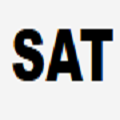Logic Artificial Intelligence (AI) is a subfield of AI where variables can take two defined arguments, True or False, and are arranged in clauses that follow the rules of formal logic. Several problems that span from physical systems to mathematical conjectures can be encoded into these clauses and solved by checking their satisfiability (SAT). In contrast to machine learning approaches where the results can be approximations or local minima, Logic AI delivers formal and mathematically exact solutions to those problems. In this work, we propose the use of logic AI for the design of optical quantum experiments. We show how to map into a SAT problem the experimental preparation of an arbitrary quantum state and propose a logic-based algorithm, called \textsc{Klaus}, to find an interpretable representation of the photonic setup that generates it. We compare the performance of \textsc{Klaus} with the state-of-the-art algorithm for this purpose based on continuous optimization. We also combine both logic and numeric strategies to find that the use of logic AI improves significantly the resolution of this problem, paving the path to developing more formal-based approaches in the context of quantum physics experiments.
翻译:逻辑人工智能(AI)是AI的一个子领域,变量可以采用两个定义的参数,即真或假,并按正式逻辑规则的条款排列。从物理系统到数学猜想的一些问题可以纳入这些条款,并通过核对其可卫星可视性来解决。相对于机器学习方法,其结果可以是近似或本地迷你,逻辑人工智能可以提供解决这些问题的正式和数学精确的算法。在这项工作中,我们提议使用逻辑AI来设计光学量子实验。我们展示了如何将任意量子状态的实验性准备工作映射到SAT问题中,并提出了一种基于逻辑的算法,称为\ textsc{Klaus},以找到生成该参数的光学结构的可解释性表示方式。我们比较了基于持续优化的上述目的的高级算法的性表现。我们还将逻辑和基于数字的算法结合起来,以发现使用逻辑AI大大改进了这一问题的解析度,为制定更正式的物理实验方法铺平了道路。




